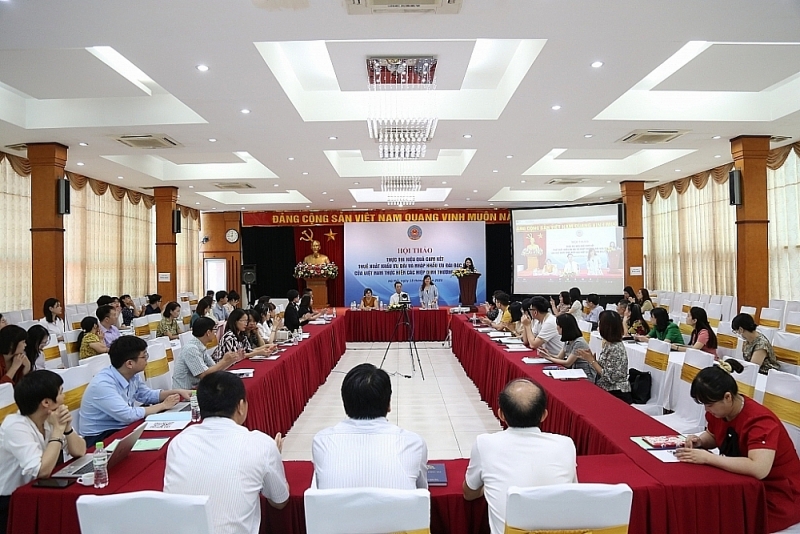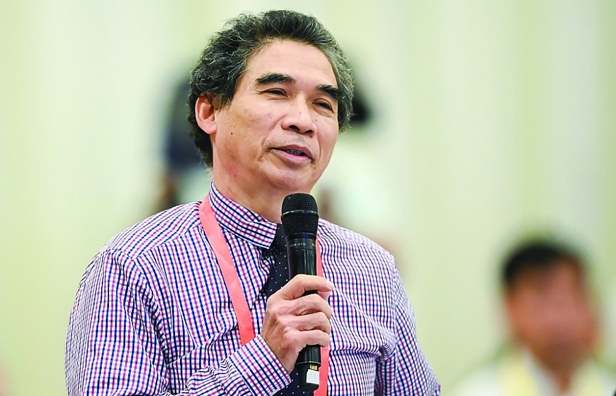 |
| View of the Workshop. |
Commitment to tax incentives in the new period helps to restructure sustainable revenue
Vietnam is implementing its commitments on preferential export tax (export) and special preferential import (import) tax within the framework of 15 FTAs and 2 bilateral trade agreements (PTA) with a coverage of more than 80% of Vietnam’s import turnover. Therefore, to be consistent with the List of Export and Import Goods, Vietnam will deploy the List of AHTN 2022 (effective from December 30, 2022) and fulfil Vietnam’s import tax commitments in the next period, the Ministry of Finance has submitted to the Government to promulgate 17 Decrees on Vietnam’s preferential export and special preferential import tariffs to implement FTAs/PTAs in the period 2022-2027 and replace the Decrees for the 2018-2022 period taking effective from December 30, 2022.
According to the Department of International Cooperation, the contents specified in the above Decrees inherit all provisions of the Decrees promulgating the Preferential Export Tariff and the Special Preferential Import Tariff of Vietnam. South to implement Free Trade Agreements/Trade Agreements in the previous period (2018-2022) to ensure policy stability and, at the same time, comply with the tariff reduction schedule committed in these agreements. Decrees are consistent with the Party’s guidelines and lines, the State’s policies, and their constitutionality and legitimacy; ensure consistency in the legal system; ensure compatibility with international treaties to which Vietnam is a member. In addition, Decree No. 129/2022/ND-CP is the first tariff decree to implement Vietnam’s commitments in the RCEP Agreement.
More specific information about several tax decrees, the International Cooperation Department said, regulations on preferential export tax for several agreements, including CPTPP, EVFTA, and UKVFTA, show that these agreements only have general regulations without specific conditions to enjoy preferential export tax rates. However, to ensure control of goods imported into the territories of the right countries and to avoid trade fraud, the Decree stipulates that the conditions for applying preferential export tax rates are having transport documents and import customs declarations or documents replacing customs declarations showing that the destination in the territories of the above countries. In addition, within 1 year from the date of registration of the export declaration, the customs declarant shall submit all documents proving that the goods satisfy the regulations and make an additional declaration to apply the preferential export tax rate beyond the time limit of 1 year, the exported goods are not eligible for the preferential export tax rate under the Agreement.
Regarding the impact of the implementation of preferential commitments, according to Ms Nguyen Phuong Linh, Head of the Department of Multilateral Financial Integration, Department of International Cooperation, the tax incentives commitments in the new period will help to further restructure the revenue sources more sustainable, reducing the proportion of revenue from import-export activities; facilitate increased efficiency in resource allocation and opportunities to participate in regional and global value chains; contribute to the shift of export structure and economic structure, and at the same time increase the competition of domestic and export goods.
Lots of drag
At the workshop, sharing about the practice of taking advantage of tariff preferences of FTAs, Ms Nguyen Thi Thu Trang, Director of the Center for WTO and Integration, Vietnam Chamber of Commerce and Industry (VCCI), said that the rate of taking advantage of preferential tariffs of imported goods is much lower than that of exports, which is quite unfortunate. From a practical perspective, in 2022, the Center surveyed to take advantage of the incentives of the EVFTA Agreement. When asked about the biggest benefit businesses receive after 2 years of implementing EVFTA, enterprises said that tariff incentives are the biggest benefits that businesses receive, which businesses benefit from export incentives greater than imports. For some businesses that have not yet taken advantage of tariff incentives, besides the reason that the MFN tax is zero, businesses do not have to take advantage of tax incentives in the EVFTA Agreement, some enterprises said that they did not know about the tax incentives provided for in this Agreement, this is also regrettable. Assessment of enterprises on the impact of FTAs in the future, Ms Trang said that most businesses believe that FTAs will have a positive impact on their production and business activities, thereby reducing difficulties and giving us an advantage when negotiating.
The representative of VCCI also said that taking advantage of tariff preferences in the agreements has many obstacles, such as market volatility, unfavourable business environment; difficulty in meeting the rules of origin to benefit; lack of specific information on commitments; some FTA commitments are detrimental to enterprises; the competitiveness of enterprises is still limited. “With internal resistance, enterprises must change themselves, and obstacles come from developing and implementing commitments; enterprises need to speak up for enforcement agencies to make adjustments,” Ms Nguyen Thi Thu Trang emphasized. For businesses to take advantage of the preferential tariff commitments of FTAs, Ms Trang said, businesses need to study the commitments of the Agreements carefully. With 17 agreements accompanied by 17 preferential export tax schedules and special preferential import taxes, when enterprises export goods to any market, they must learn the agreements that Vietnam has signed with that market to find out the preferential tariff commitments under these agreements. For example, with the Japanese market, Vietnam currently has 4 agreements; businesses need to find out the 4 different tariff schedules of these 4 agreements and the common tariff (MFN) to see which tariff is more preferential and which should be most interested in the MFN tariff. In addition, each Agreement’s preferences are tied to the rules of origin, so enterprises need to consider which Agreement’s rules of origin can be met to take advantage of that Agreement’s preferences for meeting the rules of origin. Additionally, businesses also need to learn to comply with other conditions to enjoy other incentives under the provisions of FTAs. From an enterprise perspective, the VCCI representative also suggested that the management agency should directly stipulate the most basic conditions for enjoying tax incentives and the process of enjoying preferential export tax.
 | A stepping stone to bring import-export turnover obtained 1 trillion USD by 2025 |
In this regard, Ms. Nguyen Phuong Linh also said that enterprises must actively learn about their commitments and impacts and prepare appropriate actions in the context of tax decrees issued on a rather long route. Along with that, businesses need to improve their competitiveness, create a foundation for businesses to take advantage of FTA integration opportunities, and at the same time, strengthen cooperation and linkage between businesses.
